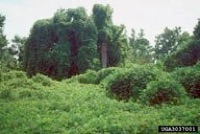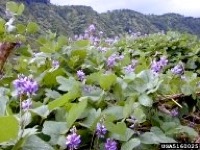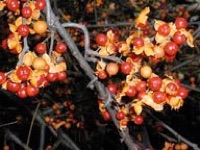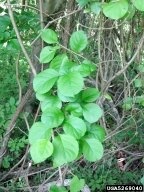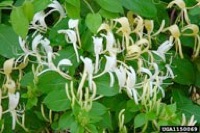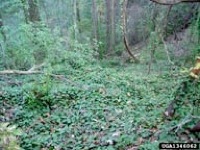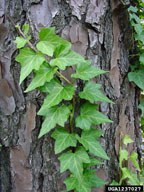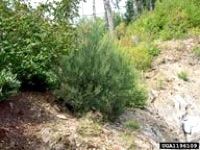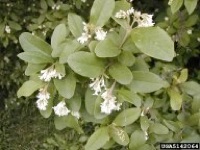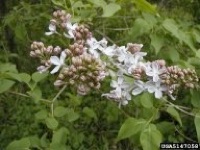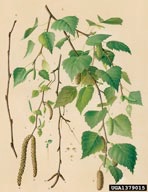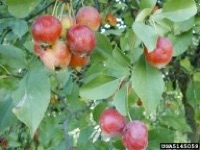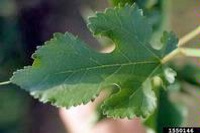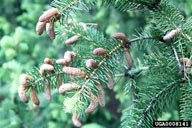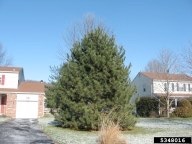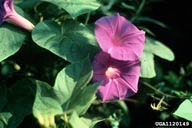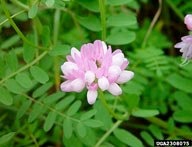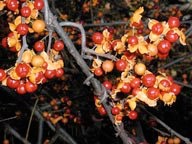Kudzu
Pueraria montana var. lobata (Willd.) Maesen & S. Almeida
Kudzu is a climbing, deciduous vine capable of reaching lengths of over 100 ft. (30.5 m). Leaves are alternate, compound (with three, usually lobed, leaflets), hairy and up to 5.4 in. (15 cm) long. Flowering occurs in midsummer, when 0.5 in. (1.3 cm) long, purple, fragrant flowers hang, in clusters, in the axils of the leaves. Fruit are brown, hairy, flat, 3 in. (7.6 cm) long, 0.3 in. (0.8 cm) wide seed pods. Preferred habitat includes open, disturbed areas such as roadsides, right-of-ways, forest edges and old fields. Kudzu often grows over, smothers and kills all other vegetation, including trees.
Kudzu is native to Asia and was first introduced into the United States in 1876 at the Philadelphia Centennial Exposition. It was widely planted throughout the eastern United States in an attempt to control erosion.
Asian Bittersweet
Celastrus orbiculatus Thunb.
Asian, or “Oriental” bittersweet is a deciduous, climbing, woody vine that can grow to lengths of 60 ft. (18.3 m). The alternate, elliptical leaves are light green in color and 2-5 in. (5-13 cm) long. Small, inconspicuous, axillary flowers develop in the spring. Fruits are round and green when young and ripen to yellow and split to reveal showy, scarlet berries that persist into winter. It closely resembles American bittersweet (
Celastrus scandens), but can be distinguished because American bittersweet has flowers and fruits at the ends of branches, rather than in the axils of the leaves. Oriental bittersweet is commonly found through the southern Appalachians in old home sites, fields, and road edges. Some shade tolerance allows it to also
grow in open forests. Prolific vine growth allows it to encircle trees and girdle them. Vines can completely cover other vegetation and shade, out-compete and kill even large trees. It can be dispersed widely and quickly due to birds eating the berries and spreading the seeds. Oriental bittersweet was introduced from China around 1860 as an ornamental. It has also been shown to hybridize with American bittersweet, potentially leading to a loss of genetic identity.
Common Daylily
Hemerocallis fulva
Common daylily was introduced to the United States from Europe in the late 19th century. It is a very popular ornamental prized for its hardiness and variety -- there are now over 40,000 registered cultivars! Daylilies that have escaped from landscape plantings infest natural areas where they pose the greatest threat to meadows, floodplains, moist woods and forest edges. Daylilies reproduce by seed and also from thick, tuberous roots that grow rapidly to form dense clumps. Gardeners inadvertently spread daylilies by throwing away whole plants. They are difficult to control because of their thick tuberous roots.
Japanese Honeysuckle
Lonicera japonica Thunb.
Japanese honeysuckle is an evergreen to semi-evergreen vine that can be found either trailing or climbing to over 80 ft. (24 m) in length. Leaves are opposite, sessile, pubescent, oval and 1 to 2.5 in. (2.5-6.4 cm) long. Flowering occurs from April to July, when showy, fragrant, tubular, whitish-pink to yellow flowers develop in the axils of the leaves. Fruits develop in the fall and are small, shiny black berries. Japanese honeysuckle invades a variety of habitats including forest floors, canopies, roadsides, wetlands, and disturbed areas. Japanese honeysuckle can girdle small saplings by twining around them, and it can form dense mats in the canopies of trees, shading everything below. A native of eastern Asia, it was first introduced into North America in 1806 in Long Island, NY. Japanese honeysuckle has been planted widely throughout the United States as an ornamental, for erosion control, and for wildlife habitat.
Japanese Knotweed
Fallopia japonica Sieb. & Zucc.
Japanese knotweed is a dense growing shrub reaching heights of 10 ft. (3 m). The semi-woody stem is hollow with enlarged nodes. Leaves are alternate, 6 in. (15.2 cm) long, 3-4 in. (7.6-10 cm) wide and broadly-ovate. Flowering occurs in late summer, when small, greenish-white flowers develop in long panicles in the axils of the leaves. Plants are dioecious (male and female flowers occur on separate plants). Japanese knotweed commonly invades disturbed areas with high light, such as roadsides and stream banks. Reproduction occurs both vegetatively (rhizomes) and seeds, making this plant extremely hard to eradicate. The dense patches shade and displace other plant life and reduce wildlife habitat. Japanese knotweed resembles giant knotweed (Polygonum sachalinense), but giant knotweed is larger and has heart-shaped leaves. Japanese knotweed is native to eastern Asia and was first introduced into North America in the late 18
Dandelion
English ivy
Hedera helix L.
English ivy is an evergreen vine that can grow to 100 ft. (30.5 m) in length. Leaves are dark-green and waxy with palmate veins. Leaf shape is very variable, but commonly occurs as a 3-5 lobed leaf with a heart-shaped base. Flowering (maturity) is triggered by sunlight, such as when the vines climb into taller vegetation. In the late summer mature plants produce terminal clusters of greenish-yellow flowers. Fruits are black and fleshy. English ivy can invade woodlands, fields and other upland areas and is spread by runners. Seeds can also be spread by birds. It can grow both along the ground, where it can displace native understory species, and in the tree canopy, often covering branches and slowly killing trees.
English ivy is native to Europe and was introduced into North America by early settlers for ornamental purposes. It continues to be widely planted as an ornamental.
Scotch broom
Cytisus scoparius (L.)
Scotch broom is a perennial shrub that grows on average from 3.3-9.8 ft. (1-3 m) tall, but can reach to 13 ft. (4 m). Leaves are small, alternate and compound with 3 leaflets. The leaves are often not noticeable, due to the dark green stems. The flowers are bright yellow, resemble sweet pea flowers and occur singly in axils of the leaves. Seed pods are fuzzy on the edges, 1-2 in. (2.5-5 cm) long and will explode when mature. Scotch broom is native to western and central Europe and occurs in coastal areas with mild, wet winters and well-drained soils. It was introduced into the United States as an ornamental in the early 1800s.
Winged burning bush
Euonymus alatus (Thunb.) Sieb.
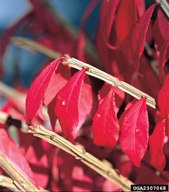
European privet
Ligustrum vulgare L.
European privet is a deciduous shrub that grows up to 15 ft. (4.8 m) in height. The trunks usually occur as multiple stems with many long, leafy branches. Leaves are opposite, oblong, 1-2.4 in. (2.5-6 cm) long and 0.2-0.6 in. (0.5-1.5 cm) wide. Flowering occurs in June, when white flowers develop at the end of branches in 1-3 in. (2.5-7.6 cm) long clusters. Fruits are spherical, 1/3 in. (8.5 mm) long, ripen to a dark purple to black color and persist into winter. Several privet species occur and they are often hard to distinguish. European privet commonly forms dense thickets in the fields or in the understory of forests. It can also be found along streams and other moist sites. Native to Europe, it is commonly used as an ornamental shrub and for hedgerows.
Common lilac
Syringa vulgaris L.
Norway maple
Acer platanoides L.
Norway maple is a deciduous tree that grows 40-60 ft. (12.2-18.3 m) tall. The opposite leaves are palmately lobed with 5-7 lobes. The margins are marked with a few large teeth. Flowering occurs in the early spring before the leaves emerge. The flowers are inconspicuous and develop into large double samaras that mature in the late summer. Norway maple is very similar to sugar maple but can be distinguished by the fruit, sap and bark. The angle of seed wings of Norway maple is approximately 180 degrees, while the angle between the seed wings of sugar maple is near 120 degrees. Broken leaf petioles of Norway maple ooze white sap while the sap of sugar maple is clear. Norway maple bark is regularly grooved, and sugar maple bark has irregular plates. Norway maple has invaded forested ecosystems throughout the northeastern United States and parts of the Pacific Northwest. Once established into a forest, it has the ability to shade out the native understory and out-compete the native tree species. Norway maple is native to Europe and was first introduced into the United States in 1756. It has been, and continues to be, widely sold as an ornamental.
Tree-of-heaven
Ailanthus altissima (P. Mill.) Swingle
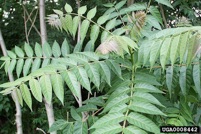
Tree of heaven is a rapidly growing, typically small tree up to 80 ft. (24.4 m) in height and 6 ft. (1.8 m) in diameter. It has pinnately compound leaves that are 1-4 ft. (0.3-1.2 m) in length with 10-41 leaflets. Flowering occurs in early summer, when large clusters of yellow flowers develop above the leaves. Fruit produced on female plants are tan to reddish, single winged and wind and water-dispersed. Tree of heaven resembles the sumacs and hickories, but is easily distinguished by the glandular, notched base on each leaflet and large leaf scars on the twigs. It is extremely tolerant of poor soil conditions and can even grow in cement cracks. Trees are not shade tolerant, but thrive in disturbed forests or edges. Dense clonal thickets displace native species and can rapidly take over fields, meadows and harvested forests. Tree of heaven, native to Asia, was first introduced into North America in 1748 by a Pennsylvania gardener. It was widely planted in cities because of its ability to grow in poor conditions.
Mimosa
Albizia julibrissin Durazz.
Mimosa is a small tree that is 10 to 50 ft. (3-15.2 m) in height, often having multiple trunks. It has delicate-looking, bi-pinnately compound leaves that resemble ferns. Flowering occurs in early summer, when very showy, fragrant, pink flowers develop in groups at the ends of the branches. Fruit are flat, 6 in. (15.2 cm) long seed pods that develop in the late summer. Mimosa invades any type of disturbed habitat. It is commonly found in old fields, stream banks, and roadsides. Once established, mimosa is difficult to remove due to the long lived seeds and its ability to re-sprout vigorously. Mimosa is native to Asia and was first introduced into the U.S. in 1745. It has been widely used as an ornamental.
European white birch
Betula pendula Roth
Poinsettia (Painted Euphorbia)
Euphorbia pulcherrima Willd. ex Klotzsch
Rose of Sharon
Hibiscus syriacus L.
Largeleaf lantana
Lantana camara
Japanese flowering crabapple
Malus floribunda Sieb. Ex Van Houtte
White Mulberry
Morus alba L.
White mulberry is a small, 30-50 ft. (9.1-15.2 m) tall, deciduous tree that invades disturbed areas throughout the United States. The alternate leaves are polymorphic (variably shaped), 2-8 in. (5.1-20.3 cm) long and shiny with blunt teeth and heart-shaped bases. Young bark, the bark along the roots, and the inner bark along the trunk are often bright orange in color. Older bark is gray with narrow, irregular fissures. Flowering occurs in April. Plants are normally dioecious (male and female flowers on separate plants). Male flowers are small, green and occur in 1-2 in. (2.5-5.1 cm) long catkins. Female flowers are inconspicuous and crowded in short spikes. White mulberry is very similar to the native red mulberry (
Morus rubra L.), but may be distinguished by the leaves. White mulberry leaves have glossy surfaces whereas the leaves of red mulberry do not. White mulberry is found throughout the United States, where it invades old fields, urban lots, roadsides, forest edges, and other disturbed areas. It poses an ecological threat by displacing native species, possibly hybridizing with and transmitting a root disease to the native red mulberry. White mulberry is native to Asia and was introduced in colonial times as a food source for silkworms.
Norway Spruce
Picea abies (L.) Karst.
Scots Pine
Pinus sylvestris L.
Japanese Black Pine
Pinus thunbergii Parl.
Japanese Yew
Taxus cuspidata Sieb. & Zucc.
Ivy-leaved Morning Glory
Ipomoea hederacea Jacq.
Multiflora Rose
Rosa multiflora Thunb. ex Murr.
Crownvetch
Securigera varia (L.) Lassen



